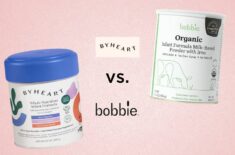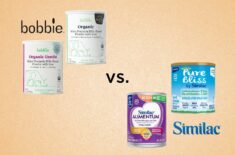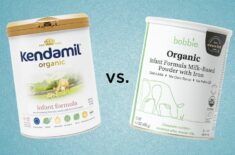Overview
Are your kiddos going back to school, or are you searching for easy and healthy lunch ideas to prepare at home? Packing lunches can be a challenge, but we’re here to help with some easy lunch ideas you can try.
Kid-friendly foods like PB&J (peanut butter and jelly) sandwiches and hard-boiled eggs are among the easiest lunch items to prepare.
But you also can’t send your kids to school with the same foods every day. And it’s also important to offer them healthy options for a balanced diet.
Studies show that around 41% of kids and adolescents in the US are overweight putting them at a higher risk for heart diseases, hypertension (high blood pressure), and diabetes (high blood sugar) later in life. (1)
They might also be at a higher risk for anxiety, depression, and social concerns such as bullying. (1)
A healthy life begins with a healthy diet that meets kids’ nutritional needs. And developing healthier eating habits is best while they’re still young.
They need enough calorie intake for energy to support their growth and development, but not over what they need.
In this article, we’ll share some easy lunch ideas, including tips on how you can encourage picky eaters to choose and eat a variety of whole foods, such as fruits and veggies.
What Foods Should Be In Your Children’s Lunch?
No matter their age, a balanced meal is important to meet your child’s nutritional needs to help them reach and maintain their ideal body weight.
A balanced meal ideally contains proteins, fats, fiber, and other nutrient-rich foods. Here are the basic components of a healthy lunch:
Proteins & Iron-Rich Foods
- Lean meat, preferably from organic, grass-fed sources
- Eggs, preferably from free-range organic chickens
- Low-mercury fish (e.g., salmon, cod, herring, halibut, and anchovies)
- Skinless poultry (e.g., chicken or turkey breast)
- Beans, chickpeas, and lentils
- Legumes
- Leafy green veggies (i.e., spinach, kale, cabbage, and lettuce)
High-Quality Fats
- Nut butters or peanut butter
- Coconut oil or coconut yogurt
- Avocado
- Ghee
- Low-fat cheese
- Unsweetened yogurt, or Greek yogurt
Fiber Sources
- Fruits and veggies (e.g., organic strawberries, bananas, apples, and sweet potatoes)
- Quinoa
- Overnight oats
- Whole-grain waffles, mini muffins, or bagels
Other Nutrient-Rich Foods
These foods are also rich in nutrients, including vitamins, calcium, zinc, and other minerals essential for your child’s growth:
- Whole grains
- Milk and dairy products (e.g., fresh mozzarella)
- Seafood (e.g., oysters)
- Unsalted nuts (e.g., almonds and cashew)
- Trail mix (without candies and chocolates)
It’s important to consult your dietitian or pediatrician before introducing allergens to your baby.
20 Easy & Healthy Lunch Ideas For Kids At Home Or In School
Veggies: Roasted cheesy broccoli
Fruits: Orange slices
Sides: Unsweetened plain or coconut yogurt
- Main: Buffalo chicken lettuce cups
Veggies: Triple bean salad (kidney beans, green beans, and garbanzo beans)
Fruits: Honeydew melon slices
Sides: Cheese roll-ups
- Main: Penne and bolognese
Veggies: Cheesy roasted asparagus
Fruits: Strawberries
Sides: Whipped sweet potatoes
- Main: Turkey, cream cheese, & avocado wrap (for a non-dairy cheese option, go for Kite Hill or Miyoko’s Creamery)
Veggies: Red bell pepper slices
Fruits: Apple slices
Sides: Almond butter
- Main: Grilled cheese sandwich (for a dairy-free option, opt for cheese slices like Miyoko’s Creamery, or Follow Your Heart; for a gluten-free bread option, go for Bread SRSLY, Canyon Bakehouse, or Udi’s)
Veggies: Celery sticks
Fruits: Mango
Sides: Marinara sauce
- Main: Beef or chicken quesadilla with bell peppers
Veggies: Cucumber & carrot sticks
Fruits:Applesauce
Sides: Guacamole
- Main: Ground beef tacos on soft tortillas (choose Siete brand tortillas for a gluten-free option)
Fruits: Apple slices
Veggies: Roasted corn & red peppers
Sides: Guacamole (you can also use this Mexican side dish as toppings for toast)
- Main: Falafel balls
Veggies: Sauteed zucchini slices
Fruits: Grapes
Sides: Hummus
- Main: Chicken pesto meatballs
Veggies: Carrot sticks
Fruits: Raspberries
Sides: Almonds
- Main: Grain/nut-free chicken nuggets
Veggies: Roasted zucchini
Fruits: Grapefruit slices
Sides: Grass-fed plain yogurt with honey (If older than one year, if your child is under one-year-old skip the honey.)
- Main: Leftover hamburgers with pickles, mustard, and ketchup
Veggies: Cucumber slices
Fruits: Watermelon chunks
Sides: Pretzels
- Main: Gluten-free short rib pasta salad with butternut squash
Fruits: Strawberries
Sides: Baked potato chips
- Main: Baked sweet potato topped with ground beef chilli
Veggies: Roasted aparagus
Fruits: Blueberries
Sides: Sour cream or coconut yogurt
- Main: Cranberry pecan chicken salad
Sides: Pita bread (you can also opt for gluten-free pita)
- Main: Rotisserie chicken with sweet potatoes and green beans
Fruits: Blackberries
Sides: Plain Greek yogurt with honey (If older than one year, if your child is under one-year-old skip the honey.)
- Main: Ground Lamb Meatballs
Veggies: Cucumber, tomato, feta salad
Fruits: Dates with almond butter
Sides: Hummus
Vegan Lunch Ideas
- Main: Tofu, zucchini, and tomato stir-fry
Fruits: Slice of peaches
Sides: Baked parsnip
- Main: Quinoa lentil-avocado bowl
Fruits: Oranges
Sides: Roasted potatoes and carrots
- Main: Quinoa, avocado & chickpea salad over mixed greens
Fruits: Apples
Sides: Roasted sweet potato wedges
- Main: Baked potato stuffed with tomatoes, and olives
Fruits: Watermelon slices
Sides: Tomato soup
Tip: These are just sample combinations. Feel free to DIY using lunch recipes you love to make at home or give some of our BLW recipes a try.
What Should A Picky Eater Have For Lunch?
You can adjust the school lunch ideas we recommend above based on your child’s normal appetite and preferences. However, it’s good to encourage your child to eat a variety of foods instead of just giving them what they want to eat.
Los Angeles-based health coach, holistic nutritionist, and wellness expert Kelly LeVeque recommends explaining to your child about how foods make them feel: (2)
“My kids are still very young and even now I’m beginning to lay the foundation for them to know what the foods they eat do for their bodies.
Different foods make us feel different ways and I want them to be able to recognize that for themselves.
I want my kids to know how healthy eating makes them feel and know the expectation of their family is that we eat to nourish our bodies.”
Another tip to get them to eat healthy foods is to let them help with meal prep. This encourages them to eat because they can feel proud that they made the food themselves.
Children’s Nutritional Needs
Overfeeding is a big no-no. Children shouldn’t be forced to finish their meals if they aren’t hungry. Although it might lead to some food waste, kids have different caloric intake requirements to meet their nutritional needs.
Consult your doctor for your child’s specific caloric needs, but the following can give you an idea about what to prepare for your kids:
Babies & Toddlers (0-2 Years Old)
During their first year, babies get most of their nutritional needs from breastmilk and/or infant formula. Once they’re ready for solid foods, introduce them to a variety of foods from different food groups.
Studies show that the BLW approach (baby-led weaning) can help your child develop good eating habits to prevent them from becoming picky eaters. (3)(4)
There isn’t a specific list of first foods to give your baby, but those rich in iron and zinc (e.g., meat, eggs, and legumes) are especially important for their growth and development at this stage. (5)(6)
Check with your pediatrician before introducing potential allergens such as eggs.
Preschoolers (2-5 Years Old)
Growth spurts at this stage require a lot of calcium for strong, healthy bones. (5)
Unless your child has a dairy intolerance or allergy, milk remains an essential diet requirement for this age, but you can also add plenty of calcium-rich foods like beans (e.g., black beans), legumes, sardines, salmon, leafy greens, and dairy products like yogurt and cheese.
Milk is a potential allergen, but hypoallergenic options are available to meet your child’s needs.
Fruits and veggies provide your child with fiber and other important nutrients, including vitamin C. Dietary fiber can help prevent constipation and heart disease. (7)
Grade Schoolers (5-12 Years Old)
Packing kids’ lunches for this age group can be challenging, especially because their friends might be getting their food from the cafeteria in school or their homemade lunches might include more “junk food.”
Your kids might be eating more candy, salty foods (e.g., pretzels), and chips while you aren’t watching.
Still, carbohydrates, proteins, calcium, and fiber are important for this age group. You can encourage them to continue eating healthy foods with fresh fruits and yummy lunchbox ideas.
Bento boxes (a lunch box with assorted food items, including carbs, meat, veggies, and dessert or some nuts usually placed in separate compartments) can be a fun way of encouraging them to eat these varieties.
Teens (13-18 Years Old)
As their bodies grow to adulthood, bone mass develops quickly at this stage. So, calcium requirements are higher for this age group. Encourage them to continue eating calcium-rich foods and drinking milk (or alternatives if they’re allergic). (5)
Boys have a higher protein requirement to build more muscles, while girls need more iron at this stage. (5)
The teenage years are vulnerable. It’s estimated that as many as 10% of young ladies in this category are at risk for developing an eating disorder. (8)
Experts suggest that parents should continue monitoring their children’s eating patterns and prioritize family dinners to address these concerns before they get worse. (5)
How To Serve A Healthy & Well-Balanced Lunch For Kids
Food Variety & Portions
Pair carbs with healthy fats and a good source of protein to keep your kids’ blood sugar balanced. You also have to consider the portions you’re packing in your kid’s lunch box.
LeVeque recommends the Fab Four eating philosophy (fats, proteins, fiber, and greens) in preparing healthy meals.
She explains: (9)
“One of the goals of the Fab 4 is to help parents look at a lunch box or a plate and say, “Where is the protein, where is the fat, where is the fiber, okay. Now count the carbohydrates.” It’s also a tool to see through marketing terms: just because it’s gluten-free, dairy-free, grain-free, sometimes it doesn’t matter. We have to look at the balance and quantity.
For example, if there are two slices of bread, 20 crackers, and a bunch of grapes in that lunchbox, that’s likely what your kid will eat. And the other stuff, the protein in there and the fat and the veggies, are probably coming home.”
What alternatives can you choose instead of this combination? LeVeque suggests offering grain-free tortilla chips instead of the bread, veggies for the crackers, and blackberries for the grapes.
Choose Certified Organic & Good Produce
Studies show that organic diets can significantly reduce your child’s exposure to harmful chemicals, such as pesticide residues and antibiotic-resistant bacteria, which can increase the risks of developing cancer and other illnesses. (10)(11)
USDA-certified organic products are free from pesticides, synthetic fertilizers, GMOs (genetically modified organisms), antibiotics, and hormones. (12)
Offer Whole Foods
It’s a good idea to serve whole foods 80% of the time.
Studies show that regularly eating minimally processed foods or whole foods close to nature can promote good health and prevent cancer, heart disease, and other chronic illnesses. (13)
For example, choose whole-grain or high-fiber bread for making toast.
The AHA (American Heart Association) recommends the following grain intake: (14)
- Around 2 oz a day for a one-year-old
- Around 7 oz a day for a 14-18-year-old boy
Avoid Or Minimize Processed Foods
They’re easy to prepare, and plenty of kids love them, but highly processed foods contain many chemicals. Many have nitrates, nitrites, coloring agents, and carcinogens (chemicals that can cause cancer). (15)
Examples can include deli meats:
- Hotdogs
- Salami
- Pepperoni
- Bologna
- Bacon
Most of these foods also contain high sodium (salt) content, which can lead to heart disease, hypertension (high blood pressure), and stroke. (16)
It’s also a good idea to avoid cereals and granola bars because these are also processed foods usually with added sugars and preservatives.
Minimize Sugar
Added sugars can impact your child’s blood glucose levels, mood, learning abilities, and eating habits. But note that there are also natural sugars in whole foods.
Low-sugar fruits include:
- Watermelon
- Avocado
- Tomato
- Cucumber
- Berries
Grapes and mangoes have high sugar content. They’re not bad for your child, but be sure to pair them with low-sugar foods for balance.
REFERENCES
(1) https://www.dietaryguidelines.gov/sites/default/files/2020-12/Dietary_Guidelines_for_Americans_2020-2025.pdf
(2) https://kellyleveque.com/recent-posts/6-tips-to-reduce-sugar-in-your-kids-meals
(3) https://pubmed.ncbi.nlm.nih.gov/30077730/
(4) https://www.ncbi.nlm.nih.gov/pmc/articles/PMC7722414/
(5) https://www.healthychildren.org/English/healthy-living/nutrition/Pages/Childhood-Nutrition.aspx
(6) http://www.rapleyweaning.com/assets/Iron.pdf
(7) https://www.healthychildren.org/English/health-issues/conditions/heart/Pages/Heart-Disease.aspx
(8) https://www.aacap.org/AACAP/Families_and_Youth/Facts_for_Families/FFF-Guide/Teenagers-With-Eating-Disorders-002.aspx
(9) https://www.levelshealth.com/blog/how-nutritionist-kelly-leveque-teaches-her-kids-healthy-food-habits
(10) https://www.ncbi.nlm.nih.gov/books/NBK100554/
(11) https://www.ncbi.nlm.nih.gov/pmc/articles/PMC1367841/
(12) https://www.usda.gov/media/blog/2012/03/22/organic-101-what-usda-organic-label-means
(13) https://www.annualreviews.org/doi/full/10.1146/annurev-publhealth-032013-182351
(14) https://www.heart.org/en/healthy-living/healthy-eating/eat-smart/nutrition-basics/dietary-recommendations-for-healthy-children
(15) https://www.consumerreports.org/deli-meats/danger-at-the-deli-cold-cuts-increased-risk-cancer-heart-disease/
(16) https://www.hsph.harvard.edu/nutritionsource/salt-and-sodium/












